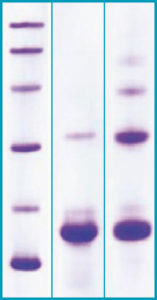sPLA2-IIA Human E. coli
Type
Recombinant
Description
Total 140 AA. MW: 15.8 kDa (calculated). UniProtKB acc.no. P14555. N-Terminal His-tag, 16 extra AA (highlighted).
Source
E. coli
Purity
Purity as determined by densitometric image analysis: >95%
SDS-PAGE Gel
12% SDS-PAGE separation of Human sPLA2-IIA
1. M.W. marker – 14, 21, 31, 45, 66, 97 kDa
2. reduced and heated sample, 10μg/lane
3. non-reduced and non-heated sample, 10μg/lane

Endotoxin
< 1.0 EU/ug
Formulation
Filtered (0,4 μm) and lyophilized in 0.5 mg/mL in 0.05M Acetate buffer pH4
Reconstitution
Add 0.1M Acetate buffer pH4 to prepare a working stock solution of approximately 0.5 mg/mL and let the lyophilized pellet dissolve completely. For conversion into higher pH value, we recommend intensive dilution by relevant buffer to a concentration of 10μg/mL. In higher concentrations the solubility of this antigen is limited. Filter sterilize your culture media/working solutions containing this non-sterile product before using in cell culture.
Applications
Western blotting
Shipping
At ambient temperature. Upon receipt, store the product at the temperature recommended below.
Storage/Expiration
Store the lyophilized protein at –80 °C. Lyophilized protein remains stable until the expiry date when stored at –80 °C. Aliquot reconstituted protein to avoid repeated freezing/thawing cycles and store at –80 °C for long term storage. Reconstituted protein can be stored at 4 °C for a week.
Quality Control Test
BCA to determine quantity of the protein.
SDS PAGE to determine purity of the protein.
LAL to determine quantity of endotoxin.
Note
This product is intended for research use only.
– Lu S, Dong Z. Overexpression of secretory phospholipase A2-IIa supports cancer stem cell phenotype via HER/ERBB-elicited signaling in lung and prostate cancer cells. Int J Oncol. 2017 Apr 19. doi: 10.3892/ijo.2017.3964
– Ronkko S, Rekonen P, Kaarniranta K, Puustjarvi T, Terasvirta M, Uusitalo H. Phospholipase A2 in chamber angle of normal eyes and patients with primary open angle glaucoma and exfoliation glaucoma. Mol Vis . Mar 26;13:408-17 (2007)

